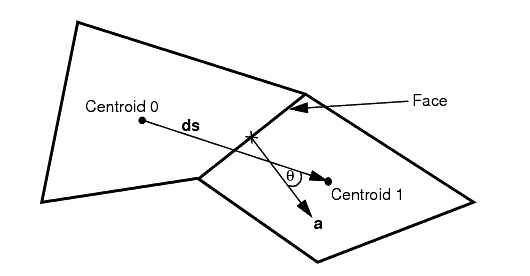What Is Cell Skewness Angle?
This skewness measure is designed to reflect whether the cells on either side of a face are formed in such a way as to permit diffusion of quantities without these quantities becoming unbounded.
To understand this measure, consider the following two-dimensional diagram of a face and the cell centroids on either side of the face:

The skewness angle is the angle between the face area vector (face normal) and the vector connecting the two cell centroids, . An angle of zero indicates a perfectly orthogonal mesh. Variables that are stored at interior faces in Simcenter STAR-CCM+ cannot be displayed; instead, the worst skewness angle for all the faces of a cell are stored in that cell. Thus, two cells often have the same skewness angle corresponding to the face that they share.
Skewness angles of or greater, which can occur in concave cells where the centroid of both cells lies on the same side of the boundary face, typically result in solver convergence issues. Problems result because the diffusion term formulation for transported scalar variables contains the dot product in the denominator, and this dot product is zero when the angle between and is . Even though Simcenter STAR-CCM+ takes care to avoid such a divide-by-zero error, the accuracy of the diffusion calculation is reduced and there is a loss of robustness in such cases.
To reduce the impact on robustness, avoid skewness angles greater than , as reported in the mesh diagnostics full report.